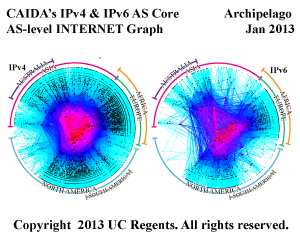In 2002, we began to create a metadata catalog where operators and other data owners could index their datasets. We were motivated by several goals we hoped the catalog would enable: data providers sharing data with researchers; researchers finding data to support specific research questions; promoting reproducibility of scientific results using Internet data; and correlating heterogeneous measurement data to analyze macroscopic Internet trends. This last goal was perhaps the most ambitious: we imagined a scenario where enough data would be richly enough indexed that the metadata itself would reveal macroscopic trends about Internet (traffic) characteristics, e.g., average packet size over time, average fraction of traffic carried via HTTP, without even needing to touch the underlying traffic data (netflow or pcap files).
To support this variety of uses of the catalog, we developed a rich metadata model that supported extremely precise descriptions of indexed data sets. For a given data set, one could specify: a description of a collection of files with similar purpose; scholarly paper, articles or publications that make use of the data; descriptions of the files containing the actual data and its format; the package format used for download; contact information; location of the data; a list of keywords; the size of the files/collection; the geographic, network, and logical location of the data; the platform used to collect the data; the start time, end time, and duration; and free form user notes. We allowed searching on any of these fields.
The catalog allows the user to not only index data but also flexibly group data sets into collections, link collections to entries describing the tools used to collect the data, and link collections to publications that used the data. We considered many corner cases and implemented our complex metadata model in an industrial strength relational database. We released the Internet Measurement Data Catalog (DatCat) in June of 2006, prepopulated with our own data sets and introduced via a hands-on workshop where we helped create scripts to assist other researchers in indexing their own data for contribution to the catalog.
In retrospect, we over-complicated the data model and the process of data indexing. Having undertaken data collection for years ourselves, we were familiar with the jargon used to describe precise characteristics of data and the variety of scenarios in which users collect Internet data. We tried to cover each and every possible case. We overshot. The result was a cumbersome and time-consuming interface. Based on feedback from those who took the time to contribute to DatCat, it became clear that we needed to streamline the submission interface. Further, we had built the original service atop an expensive, proprietary database that incurred unnecessary licensing costs.
In August 2011, NSF’s SDCI program provided support for three additional tasks building on what we learned: (1) reduce the burden on those contributing data via a streamlined interface and tools for easier indexing, annotation and navigation of relevant data; (2) convert from use of a proprietary database backend (Oracle) to a completely open source solution (Postgresql); and (3) expand DatCat’s relevance to the cybersecurity and other research communities via forums.
The new database objects have drastically fewer required fields so that contributors can more easily enter new dataset collections. The new streamlined collections require only collection name, short description, and summary fields. We have the new DatCat web site back online serving with the new open-source Postgresql database backend and streamlined interface. Also, we developed a public forums interface to hold discussions of data sharing issues and to answer frequently asked questions regarding the DatCat and the information it contains.
We hope that DatCat evolves to become a lightweight mechanism supporting operators and researchers who want to announce the availability and existence of datasets relevant to (cybersecurity) research. It could also assist NSF PIs with the new requirement that every proposal must include a data management plan for documenting types of data, data and metadata standards, policies for access, sharing, and provisions for re-use, re-distribution, and derivative works and location of archives. Finally, we hope the DatCat service will facilitate collaboration among cybersecurity and network researchers and operators around the world.
We now invite you to take a(nother) look at the Internet Measurement Data Catalog (DatCat). Please point your browser at http://imdc.datcat.org/, browse the catalog, run a few searches, crawl the keywords, create an account, and index your favorite dataset. Please send any questions or feedback to info at datcat dot org.
